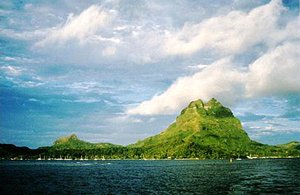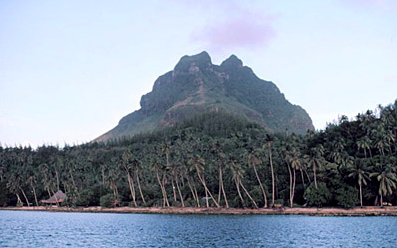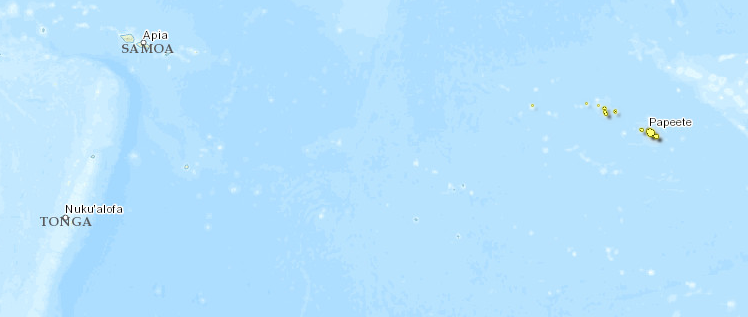Society Islands tropical moist forests
Introduction The Society Islands are strikingly beautiful volcanic and coral islands supporting hundreds of endemic species. The isolation and great age of the high islands has contributed to marked radiations in some plant and invertebrate taxa. This biodiversity (Society Islands tropical moist forests) has been seriously impacted by land clearing, fire, introduced mammals, and most recently by an introduced plant that threatens to engulf all remaining forest areas.
Location and General Description
The Society Islands comprise a chain of high volcanic islands extending from 16º to 18º S latitude and 148º to 154º W longitude. Of the 14 islands in the group, 9 are high dormant volcanoes while the remainder are atolls with volcanic substrata deep beneath. Soils are derived from basalt except in areas with uplifted reefs and on atolls where soils are limestone-derived. The Society Islands range in age from Mehetia which is less than 1 million years old, to Moorea at 1.5 million to 2 million years old, to the leeward atolls which are at least 4.5 million years old. The maximum elevation of 2,241 meters (m) is on the largest island, 1,042 km2 Tahiti. The climate is tropical with a mean annual temperature of 26 ºC. December through February is wetter with torrential rains, and March through November is drier and cooler. Annual rainfall ranges from 1,700 millimeters (mm) near sea level to at least 8,000 mm on mountain peaks. Easterly trade winds are consistent throughout half the year, and hurricanes are uncommon.
Tropical moist forest occurs in three general forms: lowland rain forest, montane rain forest, and cloud forest. Lowland forest remains only in valleys and on scattered low mountain slopes where Inocarpus fagifer, bamboo (Schizostachyum glaucifolium), Cananga odorata, Rhus taitensis, Pisonia umbellifera, introduced Aleurites moluccana, Macaranga sp., Glochidion sp., Hibiscus tiliaceus, and Tarenna sambucina are the main tree species. Medium stature montane rain forest is found on slopes above 300 m and on less wet western slopes of high islands. Common species include Alphitonia zizyphoides, Hernandia moerenhoutiana, Metrosideros collina, Fagraea sp., Canthium spp., and Wikstroemia sp. Epiphyte-laden cloud forest occurs between 400 to 1,000 m where mean annual temperature ranges from 14 to 18 °C and photosynthesis is restricted by continual cloud cover. Weinmannia parviflora and Alstonia costata are the dominant tree species, but Cyathea spp. tree ferns, Fitchia spp., Myrsine spp., Fuchusa spp., Sclerotheca spp., Cyrtandra spp., Metrosideros collina, Coprosma spp., and Psychotria spp. are also common.
Biodiversity Features
 French Polynesia. (Photograph by David Olson) Isolated in the middle of the Pacific Ocean and evolving on its own for millions of years, the fauna of the Society Island is perhaps best known for its spectacular radiation of 53 Partula land snail species thought to have derived from a single colonization event. Partula species were once found on almost all the high islands in every habitat, their beautiful shells hidden among the canopy foliage.
French Polynesia. (Photograph by David Olson) Isolated in the middle of the Pacific Ocean and evolving on its own for millions of years, the fauna of the Society Island is perhaps best known for its spectacular radiation of 53 Partula land snail species thought to have derived from a single colonization event. Partula species were once found on almost all the high islands in every habitat, their beautiful shells hidden among the canopy foliage.
About 200 years ago, bird communities in moist forest included at least 14 land bird species, including 6 endemic species and 5 regionally endemic species. The islands support a vascular flora of 623 native species including 273 endemic species and one endemic genus. Notable plant species include tree ferns (Angiopteris evecta) with 9-meter-wide canopies in Moorean valleys and a scandent cliff-dwelling Metrosideros sp.
Current Status
Since the arrival of Polynesians 1,000 to 2,000 years ago, humans have had a massive impact on the flora and fauna of the Society Islands. These islands are among the most altered, with lowland and atoll habitats largely replaced by coconut groves. Archeological sites have yielded bones of 10 seabird species, including an extinct Larus gull, and 14 land bird species no longer present in the Society Islands including 2 parrots (Vini vidivici and V. sinotoi), 3 pigeons, and a starling (Aplonis sp.) found nowhere else. Additionally, two species of Prosobonia sandpiper, 3 parrots, and 1 pigeon have become extinct since European arrival. Predation by introduced rats (Rattus rattus, R. norwegicus, and R. exulans) is the most probable cause of many of these extinctions.
A number of extant bird species are considered endangered including the green-backed heron (Butorides striatus patruelis), Society Islands pigeon (Ducula aurorae), Tahiti reed warbler (Acrocephalus caffer), Tahiti swiftlet (Aerodramus leucophaeus), and the Tahiti monarch (Pomarea nigra). Only the plants Apetahia raiateensis and Kadua sp., endemic to the central plateau of Raiatea, are considered endangered, but many more species are probably highly restricted in their distribution.
Humans have also directly impacted forests by clearing almost all areas below 500 meters (m) and burning areas frequently. This causes a transition to fire-tolerant savanna and grassland on western slopes and lowland areas. The deliberate introduction of predatory snails (Euglandina rosea and Gonaxis spp.) has resulted in the extinction or endangerment of almost all 15 endemic land snails (Samoana and Partula spp.) in the wild on Moorea and Tahiti. The only formal reserves in the Society Islands is the 10-km2 conservation area on Mt. Mara’u, Tahiti and the Fa’aiti Natural Park on Tahiti. Other areas in need of protection are lowland Inocarpus forest on Moorea, vallée de Vaiote on Tahiti, the island of Manuae, the vallée d’Avera and montane forest of Raiatea, lowland forests of Oponohu on Moorea, and seabird colonies in Tetiaroa, Fenuaura, Motuone, and Mopiihaa Atolls.
Types and Severity of Threats
Currently the greatest threat to the forests of the Society Islands is that they will all be replaced with monotypic stands of the neotropical melastome Miconia calvescens. This species, introduced in 1937, already covers 65 percent (700 km2) of Tahiti with additional populations on Moorea and Raiatea. The Miconia tree grows up to 15 meters (m) high and forms a dense canopy that shades out all but its own seedlings. The seeds are dispersed by birds, and only continuous manual control has slowed Miconia’s spread on smaller islands. It is hoped that the introduction of biological control agents from its native range might reduce its rate of spread and level of dominance. Other problematic invasive species include coffee (Coffea arabica), guava (Psidium guajava), Lantana camara, mango (Mangifera indica), African tulip tree (Spathodea campanulata), and Cecropia palmate. In total, more than 1,500 introduced plant species are present.
Justification of Ecoregion Delineation
This ecoregion includes the Society Islands of Motu One, Manuae, Maupihaa, Bora-Bora, Huahine, Raiatea, Maiao, Moorea, Mehetia, and Tahiti). Allison treats the Cooks, Societies, Tuamotus, and Marquesas as a unit herpetologically as they share a similar reptile assemblage. Van Balgooy similarly lumps the Cooks, Niue, Societies, Tuamotus, Tubaui, and Marquesas based on floristic affinities. However, Birdlife International separates the Societies from the neighboring island groups on the basis of 5 extant and 2 extinct endemic bird species. We have followed Birdlife’s lead and delineated the Society Islands as a distinct ecoregion.
Additional information on this ecoregion
- For a shorter summary of this entry, see the WWF WildWorld profile of this ecoregion.
- To see the species that live in this ecoregion, including images and threat levels, see the WWF Wildfinder description of this ecoregion.
- World Wildlife Fund Homepage
Further Reading
- Allison, A. 1996. Zoogeography of amphibians and reptiles of New Guinea and the Pacific region. Pages 407-436 in Keast, A. and S.E. Miller, editors. The origin and evolution of Pacific island biotas, New Guinea to Eastern Polynesia: Patterns and processes. SPB Academic Publishing, Amsterdam. ISBN: 905103136X
- Cowie, R.H. 1992. Evolution and extinction of Partulidae, endemic Pacific island land snails. Philosophical Transactions of the Royal Society of London Biological Sciences, 335:167-191.
- Dahl, A.L. 1980. Regional ecosystems survey of the South Pacific area. South Pacific Commission, Noumea, New Caledonia.
- Florence, J. 1987. Endemisme et evolution de la flore en Polynésie Française. Bulletin of the Zoological Society of French Polynesia, 112:370-380.
- Fosberg, F.R. 1992. Vegetation of the Society Islands. Pacific Science, 46:232-250.
- Lepofsky, D., P.V. Kirch, and K.P. Lertzman. 1996. Stratigraphic and paleobotanical evidence for prehistoric human-induced environmental disturbance on Mo’orea, French Polynesia. Pacific Science, 50:253-273.
- Meyer, J.Y. 1996. Status of Miconia calvescens (Melastomataceae), a dominant invasive tree in the Society Islands (French Polynesia). Pacific Science, 50:66-76.
- Mueller-Dombois, D. and F.R. Fosberg. 1998. Vegetation of the Tropical Pacific Islands. Springer Press, New York. ISBN: 038798285X
- Pratt, H.D., P.L. Bruner, and D.G. Berrett. 1987. The birds of Hawaii and the tropical Pacific. Princeton University Press, New Jersey. ISBN: 0691084025
- Seitre, R. and J. Seitre. 1992. Causes of land-bird extinctions in French Polynesia. Oryx, 26:215-222.
- Stattersfield, A.J., M.J. Crosby, A.J. Long, and D.C. Wege. 1998. Endemic Bird Areas of the World: Priorities for biodiversity conservation. BirdLife Conservation Series no. 7, BirdLife International, Cambridge, UK. 846 pp. ISBN: 0946888337
- Steadman, D.W. 1989a. A new species of starling (Sturnidae, Aplonis) from an archaeological site on Huahine, Society Islands (South Pacific Ocean). Notornis, 36:161-169.
- Steadman, D.W. 1989b. Extinction of birds in eastern Polynesia: a review of the record and comparisons with other Pacific island groups. Journal of Archaeological Science, 16:177-205.
- Thibualt, J.-C. 1988. Menacés et conservation des oiseaux de Polynésie Française. Pages 87-124 in J.-C. Thibualt and I. Guyot, editors. Livre rouge des oiseaux menacés des régions françaises d’outre-mer. Conseil Internatioal pur la Protection des Oiseaux (Monograph 5), Saint-Cloud.
- Van Balgooy, P.H. Hovenkamp, and P.C. Van Welzen. 1996. Phytogeography of the Pacific – floristic and historical distribution patterns in plants. Pages 191-213 in Keast, A. and S.E. Miller, editors. The origin and evolution of Pacific island biotas, New Guinea to Eastern Polynesia: Patterns and processes. SPB Academic Publishing, Amsterdam. ISBN: 905103136X
- Walters, M. 1991. Prosobonia ellisi, an extinct species of sandpiper from Moorea, Society Islands. Museo Regionale di Scienze Naturali Bollettino (Torino), 9:217-226.
| Disclaimer: This article is taken wholly from, or contains information that was originally published by, the World Wildlife Fund. Topic editors and authors for the Encyclopedia of Earth may have edited its content or added new information. The use of information from the World Wildlife Fund should not be construed as support for or endorsement by that organization for any new information added by EoE personnel, or for any editing of the original content. |

